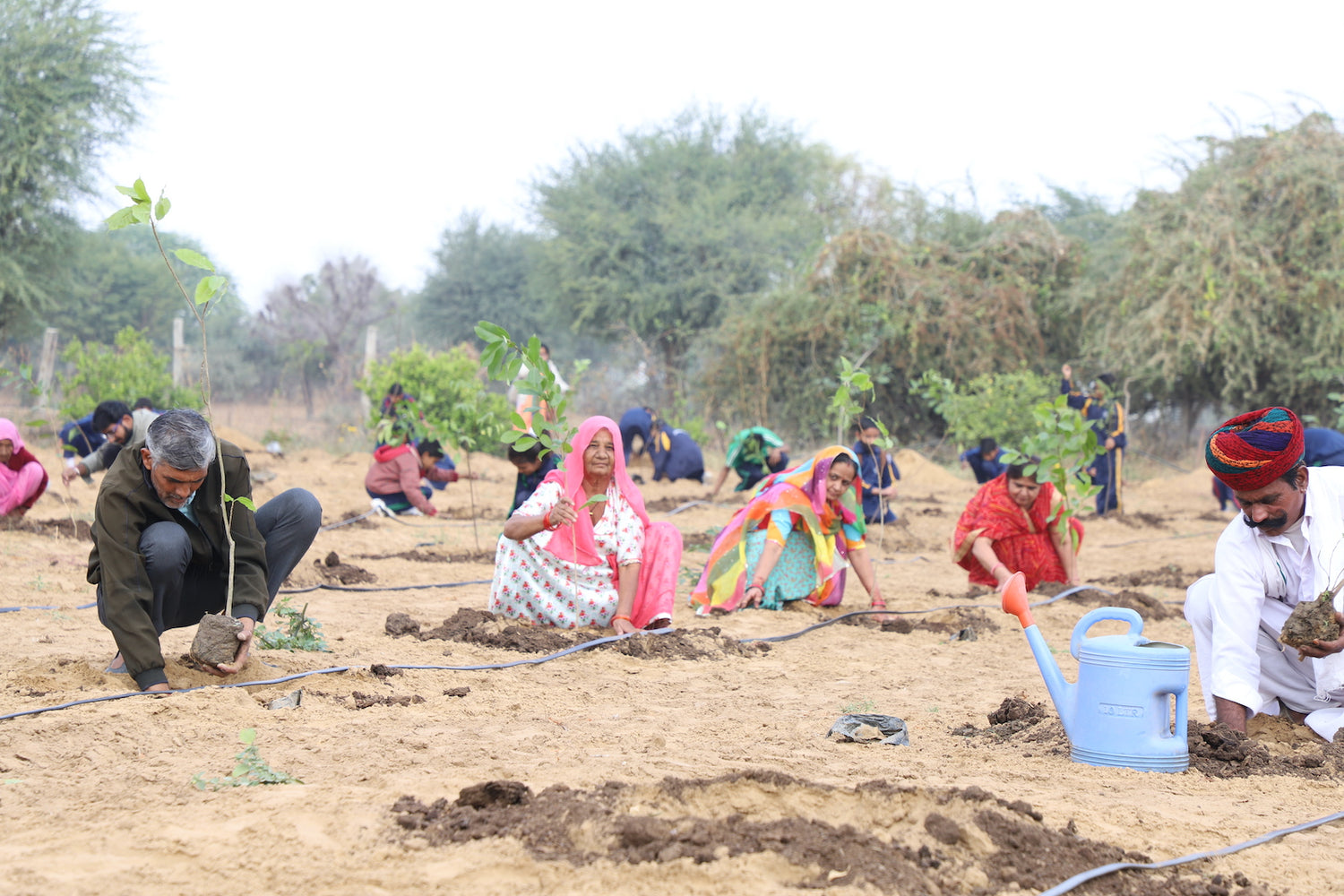Global Carbon Credit Standards: VCS, Gold Standard, CDM & More
Global Carbon Credit Standards: VCS, Gold Standard, CDM & More 🌍 As the world grapples with the pressing issue of climate change, carbon credit s Read more
Connect with us
-
👥 Corporates
If you are looking for:
- 🌲 Tree Plantation Events
- 📊 CSR Projects
📧 corporate@growbilliontrees.com
📞 +91 9699723523
💬 +91 9325931304 WhatsApp (Only)
🕒 Mon - Sat | 10am - 7pm IST
-
🧩 Tree Plantation NGOs
If you are looking for:
- 💰 Financial Assistance
- 🤝 Operational Support
📧 support@growbilliontrees.com
📞 +91 9699723523
💬 +91 9325931304 WhatsApp (Only)
🕒 Mon - Sat | 10am - 7pm IST
-
🌼 Individuals
If you are looking for:
- 👥 Group Tree Plantation Drive
- 🌳 Bulk Tree Plantation
📞 +91 9699723523
💬 +91 9325931304 WhatsApp (Only)
🕒 Mon - Sat | 10am - 7pm IST
Trending
Trees for Corporates
Global Carbon Credit Standards: VCS, Gold Standard, CDM & More 🌍
As the world grapples with the pressing issue of climate change, carbon credit standards have emerged as vital tools in the fight against global warming. These standards, including Verified Carbon Standard (VCS), Gold Standard, and Clean Development Mechanism (CDM), play a crucial role in regulating carbon offset projects and ensuring their credibility. This article delves into these standards, their historical context, environmental impact, and how organizations like Grow Billion Trees Partners are making a difference. 🌱
Understanding Carbon Credits and Standards
Carbon credits represent a permit that allows the holder to emit a certain amount of carbon dioxide or other greenhouse gases. One carbon credit is equivalent to one ton of CO2 emissions. The concept of carbon credits is rooted in the idea of cap-and-trade systems, where companies can buy and sell allowances to meet regulatory requirements.
Key Carbon Credit Standards
1. Verified Carbon Standard (VCS) 🌿
Established in 2007, the VCS is one of the most widely used voluntary carbon credit standards. It provides a robust framework for the development of projects that reduce greenhouse gas emissions. VCS projects must undergo rigorous validation and verification processes to ensure their credibility. As of 2023, over 1,600 projects have been registered under VCS, resulting in the issuance of more than 500 million carbon credits.
2. Gold Standard ⭐
Founded in 2003 by WWF and other NGOs, the Gold Standard focuses on projects that not only reduce emissions but also contribute to sustainable development. It emphasizes community benefits and environmental integrity. Gold Standard projects are known for their high-quality standards, and as of 2023, they have issued over 200 million carbon credits, supporting initiatives in renewable energy, waste management, and reforestation.
3. Clean Development Mechanism (CDM) 🌐
Part of the Kyoto Protocol, the CDM allows developed countries to invest in emission reduction projects in developing countries as a way to meet their own emission reduction targets. Since its inception in 2006, the CDM has facilitated thousands of projects, generating over 2 billion carbon credits. However, it has faced criticism for issues related to additionality and project quality.
Environmental Impact of Carbon Credit Standards
Carbon credit standards have a significant impact on the environment. They incentivize projects that reduce greenhouse gas emissions, promote renewable energy, and enhance biodiversity. For instance, reforestation projects under these standards not only sequester carbon but also restore ecosystems and provide habitats for wildlife. 🌳
According to a study by the Global Carbon Project, global CO2 emissions reached a record high of 36.4 billion tons in 2022. The implementation of carbon credit standards is crucial in reversing this trend and achieving the targets set by the Paris Agreement, which aims to limit global warming to well below 2 degrees Celsius. 🌡️
Fun Facts About Carbon Credits
- Did you know that the first carbon credit was traded in 2005? It marked the beginning of a new era in environmental finance! 💰
- Carbon credits can be bought and sold on various exchanges, including the European Union Emission Trading Scheme (EU ETS), which is the largest carbon market in the world. 🌍
- In 2021, the voluntary carbon market was valued at approximately $1 billion, and it is projected to grow significantly in the coming years! 📈
Grow Billion Trees Partners: Leading the Charge 🌳
Grow Billion Trees Partners is at the forefront of executing and promoting carbon credit projects, particularly in reforestation and afforestation initiatives. By partnering with local communities, they ensure that projects are not only environmentally sustainable but also socially responsible. Their approach includes:
- Community Engagement: Involving local populations in project planning and execution to ensure that their needs and knowledge are integrated. 🤝
- Monitoring and Verification: Utilizing advanced technologies to track the progress and impact of projects, ensuring transparency and accountability. 📊
- Education and Awareness: Promoting the importance of carbon credits and sustainable practices through workshops and outreach programs. 📚
Through these efforts, Grow Billion Trees Partners not only contributes to carbon offsetting but also enhances biodiversity, improves air quality, and supports local economies. 🌱
Conclusion
As the urgency to combat climate change intensifies, understanding and supporting carbon credit standards like VCS, Gold Standard, and CDM becomes essential. Organizations like Grow Billion Trees Partners are leading the way in implementing effective projects that not only reduce emissions but also foster sustainable development. By participating in these initiatives, individuals and businesses can play a pivotal role in creating a greener, more sustainable future. 🌍💚
You may like
Global Carbon Credit Standards
The elite club of carbon credits where VCS, Gold Standard, and CDM mingle. Think of it as the Oscars for carbon offsets, where only the best get to strut their stuff on the red carpet of sustainability.
VCS (Verified Carbon Standard)
The cool kid on the block, VCS is like that friend who always has the latest gadgets. It verifies projects that reduce greenhouse gases, ensuring they’re not just blowing hot air.
Gold Standard
Not just a shiny name, Gold Standard is the gold medalist in the carbon credit race. It focuses on sustainable development, proving that saving the planet can also be a win-win for communities.
CDM (Clean Development Mechanism)
The diplomat of carbon credits, CDM helps developed countries invest in green projects in developing nations. It’s like a global potluck where everyone brings a dish to share for a healthier planet.
Carbon Offset Projects
These are the superheroes of the carbon world, swooping in to save the day by reducing emissions. From reforestation to renewable energy, they’re the real MVPs in the fight against climate change.
Sustainable Development Goals
The UN’s ambitious checklist for a better world, these goals are like the ultimate to-do list for humanity. They align perfectly with carbon credit standards, proving that saving the planet can also be a team sport.
Carbon Footprint
The not-so-great legacy we leave behind, our carbon footprint is like that embarrassing photo from high school. It’s time to shrink it down and make sure it doesn’t haunt us in the future.
Renewable Energy Credits
The cool cousin of carbon credits, these credits are all about promoting clean energy. They’re the life of the party, ensuring that every watt of renewable energy gets the recognition it deserves.
Emission Reduction
The name of the game in the carbon credit world, emission reduction is like a diet for the planet. It’s all about cutting back on the bad stuff and making room for a healthier, greener future.
Climate Change Mitigation
The fancy term for fighting climate change, mitigation is like putting on a superhero cape. It’s all about taking action to reduce the impacts of climate change before it’s too late.
Carbon Market
The bustling marketplace where carbon credits are bought and sold, the carbon market is like Wall Street for the eco-conscious. It’s where financial savvy meets environmental responsibility.
Regulatory Framework
The rulebook for carbon credits, this framework is like the referee in a game. It ensures that everyone plays fair and that the carbon credit system doesn’t turn into a free-for-all.
Corporate Plantations
FAQ
What are Global Carbon Credit Standards?
Think of them as the rulebook for carbon credits, ensuring that when you plant a tree or reduce emissions, it’s legit. VCS, Gold Standard, and CDM are the VIPs in this club, making sure your green efforts are recognized and rewarded.
Why should I care about VCS?
VCS, or Verified Carbon Standard, is like the gold star of carbon credits. It ensures your projects are credible and effective. If you want your carbon offset to shine brighter than your neighbor’s solar panels, VCS is your go-to.
What makes Gold Standard special?
Gold Standard is the crème de la crème of carbon credits. It not only focuses on reducing emissions but also on sustainable development. Think of it as the eco-friendly superhero, saving the planet while making communities thrive.
How does the CDM work?
The Clean Development Mechanism (CDM) is like a carbon credit matchmaking service. It connects developed countries with projects in developing nations, allowing them to offset emissions while helping others. It’s a win-win, like sharing your dessert with a friend.
Can I trust these standards?
Absolutely! These standards are like the bouncers at an exclusive club, ensuring only the best projects get in. They undergo rigorous verification processes, so you can rest easy knowing your carbon credits are the real deal.
How do I choose the right standard?
Choosing a standard is like picking a favorite ice cream flavor—everyone has their preference! Consider your project goals, location, and the impact you want to make. Each standard has its unique flavor, so taste-test before you commit.
Are these standards globally recognized?
Yes, they are the rock stars of the carbon credit world! VCS, Gold Standard, and CDM are recognized internationally, making your carbon credits valid and valuable across borders. It’s like having a passport for your eco-friendly efforts.
What types of projects qualify?
From renewable energy to reforestation, the options are as diverse as a buffet! Each standard has its criteria, but generally, any project that reduces emissions or enhances carbon sinks can qualify. Just make sure it’s a good fit for the standard you choose.
How do I get started with carbon credits?
Getting started is easier than finding a cat video online! First, identify your project, then choose a standard that aligns with your goals. After that, follow the guidelines to get your credits verified. Soon, you’ll be on your way to saving the planet!
What’s the difference between voluntary and compliance markets?
Think of voluntary markets as the free-spirited artists of carbon credits, while compliance markets are the serious business folks. Voluntary markets allow individuals and companies to offset emissions on their own terms, while compliance markets are regulated by law.
Can I sell my carbon credits?
Yes, you can! If your project generates carbon credits, you can sell them like hotcakes. Just ensure they’re verified and meet the standards. It’s a great way to fund your next eco-adventure while helping the planet.
How do these standards impact climate change?
These standards are like the superheroes of climate action, driving real change by ensuring projects deliver genuine emissions reductions. By adhering to these standards, we can collectively tackle climate change, one carbon credit at a time.























